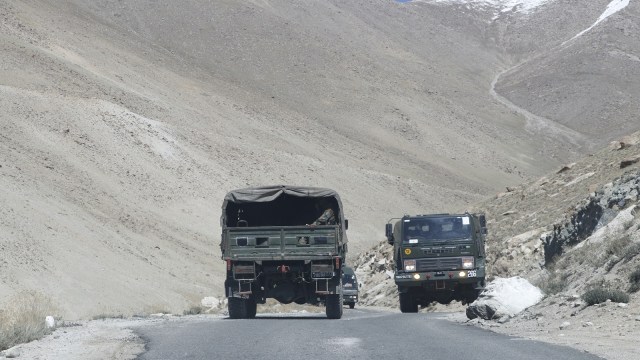India, China disengagement almost over in Depsang and Demchok, patrolling to begin in next 2 days
The Indian and Chinese armies will commence a ‘coordinated’ patrolling of areas they were unable to reach after the stand-off began in April 2020, Army sources said.
 A convoy of Indian army vehicles near Khuru Leh making its way towards Eastern Ladakh where India and China are locked in a face-off over along Line of Actual Control. (Express Archives)
A convoy of Indian army vehicles near Khuru Leh making its way towards Eastern Ladakh where India and China are locked in a face-off over along Line of Actual Control. (Express Archives)The disengagement process of Indian and Chinese troops in Ladakh’s Depsang and Demchok is expected to be completed on Tuesday. Both armies will henceforth commence the ‘coordinated’ patrolling of areas they were unable to reach after the stand-off began in April 2020, Army sources said.
Sources in the Army added that the dismantling of temporary structures in these two areas is almost complete and a certain amount of verification has already taken place on both sides. The verification process is being done physically as well as using unmanned aerial vehicles (UAVs).
Troops on both sides are also being withdrawn to be stationed at depth in the rear locations as part of the disengagement process. The patrolling which will be undertaken to points hitherto inaccessible since April 2020 will be done by small parties of troops numbering around 10 to 15 soldiers.
The verification of the disengagement is also being done with mutual coordination and the presence of officers from both armies.
Satellite images in the public domain have also shown that the temporary structures in Depsang and Demchok have been dismantled by the Chinese.
India and China have been locked in a military standoff along the Line of Actual Control in eastern Ladakh following Chinese incursions over four-and-a-half years ago. Last week, four days after India announced that an agreement on patrolling in the Depsang Plains and Demchok had been reached with China, Beijing had affirmed the same, saying that “the Chinese and Indian frontier troops are engaged in relevant work, which is going smoothly at the moment”.
Sources in the Army said that following the completion of the verification process, the coordinated patrolling will begin within the next two days. Prior information will be given by both sides so that there is no danger of a face-off.
A similar arrangement is also being worked out in Arunachal Pradesh where a stand-off developed in Yangtse, Asaphila and Subansiri valleys, sources said.
In Depsang, the Indian troops should now be able to patrol beyond the ‘bottleneck’ area as the Chinese had been preventing Indian troops from accessing the patrolling points that lay beyond. In Demchok, Indian troops should now be able to get to the patrolling points at Track Junction and Charding Nullah.
However, the large number of Indian troops rushed to Ladakh after the stand-off in 2020 will continue to remain in place till a wider consensus on the border patrolling mechanism is reached with the Chinese, Army sources said. There are no plans to move back any troops from Ladakh in the near future till an atmosphere of mutual trust and verification is established, sources added.







